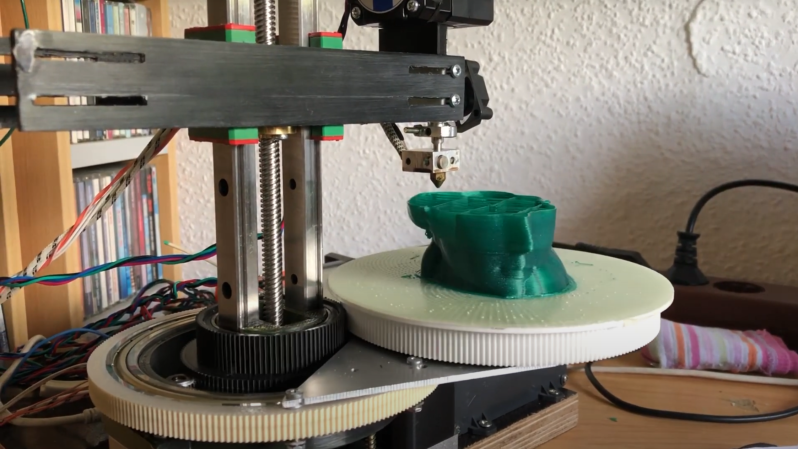There are some times when a picture, or better yet a video, really is worth a thousand words, and [heinz]’s dual-disk polar 3D printer is one of those projects. Perhaps the best way to describe it is as an inverted SCARA system that moves the print bed around the hot end, producing strange and mesmerizing motion paths.
The Z-axis runs on a column through the center of the printer, while the print bed is a geared disk that can independently rotate both around its own center and around the central column. This gives the printer a simple way to use multiple extruders: simply mount the extruders at different angles around the central pillar, then rotate the bed around to whichever extruder is currently in use. (See the video demo below.) Since the extruder only moves in the Z direction, there’s also no need to make it as light as possible. In one test, it worked perfectly well with a five-filament direct-drive extruder assembly weighing two kilograms, though it proved a bit unwieldy.
[heinz] 3D printed the rotating disks and a few other parts of the printer, and used two GT2 timing pulleys and the bearings from a Lazy Susan to drive the disks and let them rotate. The print bed’s surface is made out of fiberglass, and since it’s unheated, it has a pattern of small holes drilled into it to let molten plastic seep in and adhere. One nice side effect of the rotating print bed is that it can produce a turntable effect on time-lapse videos.
We’ve covered this project once before when it was a bit earlier in development, and somehow we missed when it got upgraded to its current status. Let’s just say we’re impressed!
Polar 3D printers may make it a bit harder to visualize paths, but they can do unique things like print with four heads at a time or print in non-planar paths.
















I’m irrationally irritated by it. I can’t quite put a finger on it. Clearly the solution works fine, and, is indeed a valid solution.
Ugh. I appreciate it as an article.
the build appears wobbly and unstable
Huge footprint relative to build area
Flipped upside down with toolheads on the small circle would give you plenty of room for multiple printheads while opening up most of the footprint to build area.
it’s like a waiter carrying a plate on one hand and you don’t know if he’s going to drop it. I do like how there doesn’t seem to be a dead zone in the center of the disk.
This is fabulous. I love seeing original concepts for 3D printers. Motion systems beyond the i3/CoreXY/Delta standards are always exciting.
okay so its not 3d printing, its waterjet cutting, but if youd like to see an interesting motion system, check out this pastry cutter by Mtec. Its a giant free floating sprocket being driven by two independent chain drives
https://youtu.be/EOOtx4T7OcA?si=NKy_n6S73X_r2Afg&t=10
There is NO WAY that this produces quality 3-D printed forms. Toooooo MANY moving parts.
Two. Two moving parts.
Its a rotary axis offset to a second rotary axis.
Complain about the sloppy shakiness, but NOT the number of moving parts.
Have you seen a delta printer?